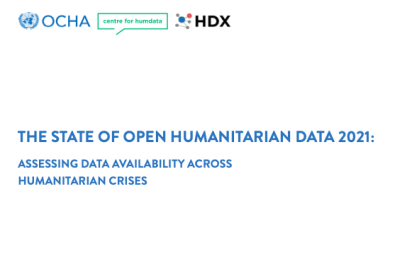A new report outlines the availability of data in humanitarian settings around the world. The 2021 edition of “The State of Open Humanitarian Data”, recently published by the Centre for Humanitarian Data of the United Nations Office for the Coordination of Humanitarian Affairs (OCHA), explores the state of the humanitarian data ecosystem and identifies gaps in data availability.
Humanitarian data refers to “(1) data about the context in which a humanitarian crisis is occurring (e.g., baseline/development data, damage assessments, geospatial data); (2) data about the people affected by the crisis and their needs; and (3) data about the response by organisations and people seeking to help those who need assistance”. In “The State of Open Humanitarian Data” reports, humanitarian data is collected using the Humanitarian Data Exchange (HDX) platform. The HDX platform is publicly accessible and contains over 18,000 data sets. It is managed by the Centre for Humanitarian Data at UN OCHA, which aims to “create a future where all people involved in a humanitarian situation have access to the data they need, when and how they need it, to make responsible and informed decisions”.
According to the report, an increasing awareness around gathering and disseminating humanitarian data sensibly and an organisational shift towards automated data-sharing have strengthened the humanitarian data ecosystem. On the topic of humanitarian data availability, the report points to numerous gaps. It uses so-called Data Grids as a reference point for this analysis, which “bring together a limited set of foundational datasets within six comparable categories” in order to contrast data availability across various places. Data Grids comprise 24 data sets on average per location. It estimates that “at the start of 2021, just 51 percent of relevant, complete crisis data is available across 27 humanitarian operations”. When including data that is applicable but deficient this number goes up to 75 percent, leaving still “25 percent of categories with data that does not meet the criteria or with no data”.

Earth observation (EO) data can play a vital role in closing this gap on humanitarian data availability. EO data is an important factor in facilitating humanitarian action in disasters all over the world. In fact, space-based information has the potential to support all the stages of the disaster management cycle, from prevention to recovery. The increased integration of EO data into humanitarian data sets, such as those found on the HDX platform, could therefore aid in filling crucial gaps in data coverage and developing a more comprehensive overview of the humanitarian data ecosystem.

